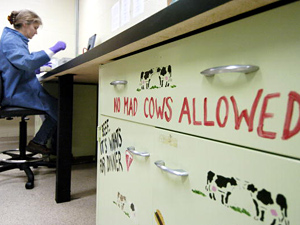|
Audio
Photos
More from MPR
|
January 11, 2005
Canadian officials have announced a second case of confirmed mad cow disease. It's the second case of the disease this year in a Canadian animal. The U.S. Department of Agriculture will send a technical team to Canada to asses the situation and could modify its decision to resume trade with Canada.
Sioux Falls, S.D. — The Canadian Food Inspection Agency says the second case of the brain-wasting disease showed up in Alberta. The cow is younger than seven years old. That means it was born after a 1997 law required a change in the ingredients for cattle feed. The ban removed ruminants in feed. They're believed to be the cause of the disease.
This is the second case of bovine spongiform encephalopathy -- BSE -- found in Canada this year. Last week officials announced they found BSE in another eight-year-old cow from Alberta. That case was reported just a day after the United States said it planned to reopen its border to Canadian beef in March. The border was closed in May 2003 after another positive case of BSE.
Congressional representatives from around the Upper Midwest are calling for the USDA to keep the borders closed. Sen. Tim Johnson, D-S.D., says the USDA needs to "take a deep breath" and understand the scope of the problem before opening the border. Johnson says it's a consumer confidence issue.
"And it also further underlines the importance of implementing the country of origin labeling law in the United Sstates, so along with the rest of the industrialized world, our consumers at the very least have the ability to make an intelligent choice about the meat that they buy they can know the origin of the food they're feeding their family," Johnson said.
Earlier this week a cattlemen's group sued the USDA to prevent live cattle and expanded beef imports from Canada. The lawsuit by R-Calf USA said the USDA plan would pose a risk to consumers and U.S. producers.
"Our government has always taken the stance that we would prevent a foreign animal disease and in this case the USDA has flip-flopped and now is in the mode of wanting to 'manage a disease,' instead of prevent it," said Shae Dodson, the spokesperson for R-Calf.
Dodson claims Canada isn't doing enough testing to provide consumer confidence.
"We are worried that if Canada is only testing animals with symptoms or older animals there is the possibility that meat tainted with BSE will cross into the United States and an unsuspecting consumer could eat it and in 8-11 years could come down with variant Creutzfeldt-Jakob disease. We don't want that to happen."
An agriculture economist from Iowa State University says food safety is not the issue. John Lawrence says Canadian ranchers are doing the same things the United States is doing to prevent the spread of BSE.
Lawrence says the only thing wrong with the USDA plan to open the Canadian border is that it would happen in March. He says trade between the United States and Japan wouldn't reopen until May or later. Japan closed trade with the U.S. when a BSE cow was found in Washington State. The cow was born in Canada. Lawrence says most cattle ranchers are upset the market would be flooded with Canadian beef before they can export it.
"The golden rule applies in international trade. Do unto others as you would have them do unto you. And so as we try to get the Japanese border open, they're saying, 'well, wait a minute. You won't trade with Canada. You won't accept their product and you want us to accept yours. You get your own house in order and then come and talk with us,'" said Lawrence.
Some experts say that labelling would help this situation, if it told consumers what country their meat came from. Lawrence disagrees that so-called, country of origin labeling would make a difference. He says it's likely companies would package meat born and raised in the US, for the meat counter.
Material from other countries would still get into the food chain, as ingredients in prepared and packaged food.




